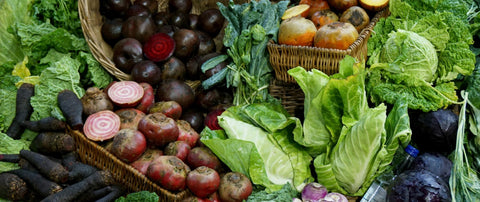Many people are familiar with the terms alkaline and acidic from chemistry lessons, when the pH values of various substances were determined using yellow strips. But what is alkaline nutrition all about? The acid-base balance is an important factor to consider for a healthy and balanced diet. We explain why an alkaline diet can be beneficial and how it works.
Contents
What is the body's pH value?
In general, all substances that have a pH value of more than 7 are alkaline and all those that are below 7 are acidic. A value of 7 is considered pH-neutral. There are many different environments in our body, each of which has a different pH value. Our skin, for example, has a pH of 5.5-6.5, which is slightly acidic. This is because a slightly acidic environment makes it difficult for bacteria and microbes to survive and multiply on the skin. We also call this the "protective acid mantle of the skin". Washing too often with strongly alkaline detergents (e.g. soap) can increase this pH value and thus destroy the protective layer. It is therefore better to use a mild, soap-free detergent for daily washing.
With a value of 1.5, our stomach acid is one of the most acidic substances of all, which promotes the dissolving and processing of food. Anyone who has ever had heartburn knows that stomach acid is a very irritating substance. If the stomach is confronted with particularly large amounts of food or very fatty food, it produces more stomach acid. This can lead to the stomach lining becoming overly acidic and excess stomach acid flowing into the oesophagus, where it causes irritation. Neutralisation and relief of symptoms can be achieved by taking alkaline remedies, which bring the pH value back into balance.
Human blood normally has a pH of 7.5. To prevent this from fluctuating too much, the lungs, kidneys and liver have certain "buffer mechanisms" that can compensate for short-term fluctuations. A higher CO2 content in the blood, for example, lowers the pH value and thus regulates it via respiration. A permanent change in the pH value may indicate a disease of the lungs, kidneys or liver. A strong acidification of the blood occurs, for example, in the case of alcohol poisoning, severe diarrhoea or starvation.
What does "alkaline" mean in nutrition?
A relatively unstable pH value in the human body is that of urine. Depending on what we eat and drink in a day, how effective our digestion is, whether we exercise or not, our urine can be acidic or alkaline. This is because an excess of acids is primarily regulated by the kidneys and excreted via the urine. The pH value of the urine therefore indicates whether someone's diet is more acidic or alkaline.
The regulation of the pH value works via the release of calcium phosphates and calcium carbonates, which neutralise the excess acids and can then be measured in the urine. It is estimated that a person on a highly acidic diet will excrete around 480g of calcium over 20 years. That's quite a lot when you consider that our entire skeleton contains around 1150g of calcium.3 This means that an acidic diet results in a greatly increased need for calcium, which those affected may not even realise. As calcium is particularly important for building and maintaining muscles, nerves and bones, a permanent deficiency can lead to serious problems. Symptoms such as muscle cramps and twitching through to osteoporosis as a late consequence can be attributed to a calcium deficiency.
How do you measure the acidity of food?
In this case, the fact that something is considered acidic says neither anything about the flavour nor about the pH value. Rather, it is about which processes the food drives and triggers in the body. This is why the term " acidifying" is usually used. Acidifying foods cause acids to be released in the body when they are metabolised and increase inflammation levels. They usually have a very low water content so that water is drained from the body for processing and excretion. They also contain little to no antioxidants or other beneficial plant substances that protect the body against oxidative stress. In this way, acidifying foods disrupt the body's natural acid-alkaline balance. This results in an excess of acid or acidosis. The most common diet in Western industrialised nations is rich in salt, dairy products and meat, as well as highly processed foods such as cereals and convenience foods that are low in vitamins and minerals. These are all foods that are considered acidifying. An alkaline diet therefore aims to balance the acid-alkaline balance in order to end or avoid the over-acidified state of acidosis and thus support the body.
All these factors have an effect on the load on the kidneys, which have to excrete the resulting acids. This is why the PRAL value is used to categorise foods as acidifying or alkalising. This stands for Potential Renal Acid Load.2 The higher the PRAL value, the more acidifying the food. The PRAL value of alkalising foods, on the other hand, goes into the negative range. This shows that they can balance out the values of acidifying foods. Below we have listed some foods that are highly acidifying and alkalising.

These foods are acidifying
| Foods | PRAL value |
|---|---|
| Parmesan cheese | 34,2 |
| Egg yolk | 23,4 |
| Matured cheese (average) | 19,2 |
| Beef (corned beef) | 13,2 |
| Brown rice | 12,5 |
| Trout | 10,8 |
| Curd cheese | 11,3 |
| Rolled oats | 10,7 |
| Veal | 9,0 |
| Peanuts | 8,3 |
| Eggs, whole | 8,2 |
| Walnuts | 6,8 |
| Frankfurter Sausages | 6,7 |
| Spaghetti, white | 6,5 |
| White rice | 4,6 |
| Lentils | 3,5 |
| Wholemeal bread | 1,8 |
Source: 2
Even at first glance, you can see that there are virtually no vegetables among the acidifying foods, but many meat and dairy products. Of course, this does not mean that these acidifying foods should be completely avoided in an alkaline diet. It is more a question of consuming these components of the diet more consciously so that the acid-base balance does not fluctuate too much towards acids.
These foods are alkalising
| Foods | PRAL value |
|---|---|
| Spirulina powder | -22,1 |
| Spinach | -14 |
| Currants | -6,5 |
| Bananas | -5,5 |
| Pomegranate | -5,3 |
| Celery | -5,2 |
| Apricots | -4,8 |
| Aubergines | -3,4 |
| Tomatoes | -3,1 |
| Orange juice, unsweetened | -2,9 |
| Appples | -2,2 |
| Broccoli | -1,2 |
| Cucumbers | -0,8 |
Sources: 2, 4
Here, too, it is easily seen that vegetables and fruit are among the most alkalising foods. Once again it becomes clear that the PRAL value has nothing to do with flavour. Citrus fruits and berries, which often have a sour flavour, all have a neutral or negative, i.e. slightly alkaline to alkaline PRAL value.
However, the absolute frontrunner by far is the microalgae spirulina. Not only is it highly alkalising, it is also rich in many important macro and micronutrients as well as secondary plant substances. It is ideal as an addition to bowls, smoothies or shakes for an alkaline diet. However, this table should not be regarded as exclusive, as the nutrient content, for example, is not taken into account in the PRAL value. An alkaline diet is not necessarily balanced just because it consists exclusively of alkalising foods.

Get marine support for your alkaline diet!
Ad
The positive effects of an alkaline diet
We generally speak of an "alkaline-forming diet" when the proportion of alkaline-forming foods in the diet is 70-80% and the percentage of acid-forming foods is 20-30%. Many positive effects on health have already been observed with a diet rich in alkaline-forming components such as fruit and vegetables. For example, researchers have found that the incidence of hip fractures in older women is lower in countries where fruit and vegetables make up a significantly higher proportion of the diet than meat and dairy products. They therefore recommend an alkaline-rich diet for bone health and stability.5 Further studies suggest that adiet rich in alkalizing fruit and vegetables is easy on the kidneys and can prevent kidney damage in the long term.6, 8
The Alkaline diet - how to succeed
As already mentioned, an alkaline diet is about the ratio of acid-forming to alkaline-forming foods so that the acid-alkaline balance is in equilibrium. This means that you don't necessarily have to give up anything when switching to an alkaline diet. You can achieve the right ratio by planning your meals around alkaline foods as the main component. Any acidifying foods you want to eat should then only be added as a bonus.
However, this does not mean that you should only eat foods with a negative PRAL value when you are on an alkaline diet. There are certain so-called "good acidifiers" that have an acidifying effect, but at the same time supply the body with important minerals or stimulate the formation of amino acids. These include, for example, pulses, nuts, fruit or pseudo-cereals such as buckwheat and quinoa. Ideally, these should make up the 20-30% of acidifiers in your diet.
Perhaps you already eat a mostly alkalising diet and would like to give your body an extra portion of alkalising foods from time to time. In this case, tablets or powders are particularly suitable, which you can take between meals or stir into your bowl or smoothie. Spirulina microalgae is a good addition to a balanced alkalising diet. In addition to a highly alkaline PRAL value, it has a broad spectrum of vital substances and thus offers you a daily alkaline nutrient boost. You can find out more about this in this article (Chlorella vs Spirulina).
Sources:
- Larsen R. Störungen des Säure-Basen-Haushalts. Anästhesie und Intensivmedizin für die Fachpflege. 2016 Jun 14:822–31. German. doi: 10.1007/978-3-662-50444-4_58. PMCID: PMC7531422. https://www.ncbi.nlm.nih.gov/pmc/articles/PMC7531422/
- Schwalfenberg GK. The alkaline diet: is there evidence that an alkaline pH diet benefits health? J Environ Public Health. 2012;2012:727630. doi: 10.1155/2012/727630. Epub 2011 Oct 12. PMID: 22013455; PMCID: PMC3195546. https://www.ncbi.nlm.nih.gov/pmc/articles/PMC3195546/
- Fenton TR, Eliasziw M, Lyon AW, Tough SC, Hanley DA. Meta-analysis of the quantity of calcium excretion associated with the net acid excretion of the modern diet under the acid-ash diet hypothesis. Am J Clin Nutr. 2008 Oct;88(4):1159-66. doi: 10.1093/ajcn/88.4.1159. PMID: 18842807. https://pubmed.ncbi.nlm.nih.gov/18842807/
- https://www.naehrwertrechner.de/naehrwerte/G004511/Spirulina+Pulver/?menge=100
- Frassetto L, Morris RC Jr, Sellmeyer DE, Todd K, Sebastian A. Diet, evolution and aging--the pathophysiologic effects of the post-agricultural inversion of the potassium-to-sodium and base-to-chloride ratios in the human diet. Eur J Nutr. 2001 Oct;40(5):200-13. doi: 10.1007/s394-001-8347-4. PMID: 11842945. https://pubmed.ncbi.nlm.nih.gov/11842945/
- Frassetto L, Remer T, Banerjee T. Dietary Contributions to Metabolic Acidosis. Adv Chronic Kidney Dis. 2022 Jul;29(4):373-380. doi: 10.1053/j.ackd.2022.03.008. PMID: 36175075. https://pubmed.ncbi.nlm.nih.gov/36175075/
- Remer T, Manz F. Potential renal acid load of foods and its influence on urine pH. J Am Diet Assoc. 1995 Jul;95(7):791-7. doi: 10.1016/S0002-8223(95)00219-7. PMID: 7797810. https://pubmed.ncbi.nlm.nih.gov/7797810/
- Scialla JJ, Anderson CA. Dietary acid load: a novel nutritional target in chronic kidney disease? Adv Chronic Kidney Dis. 2013 Mar;20(2):141-9. doi: 10.1053/j.ackd.2012.11.001. PMID: 23439373; PMCID: PMC3604792. https://pubmed.ncbi.nlm.nih.gov/23439373/




 DE-ÖKO-006
DE-ÖKO-006
